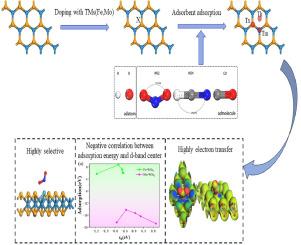Study on highly selective NO2 gas sensors based on (Fe, Mo)-doped monolayer WSe2
IF 4.6
2区 物理与天体物理
Q1 PHYSICS, MULTIDISCIPLINARY
引用次数: 0
Abstract
The two-dimensional (2D) material WSe2 is frequently employed in gas sensors due to its excellent electrical properties. However, the weak interaction between the pristine WSe2 and gas molecules limits its application. Therefore, in this paper, the adsorption behavior of transition metal X (X = Fe, Mo) atom-doped monolayers WSe2 on H and O atoms and molecules of NO2, HCN, and CO gases is investigated to gain insights into the physical mechanisms of adsorbent-substrate interactions. Doping significantly improves the adsorption properties between the substrate and the gas molecules, with the best adsorption showing for NO2 gas molecules and O atoms. The relationship between transition metals and the improvement of adsorption performance is explored by the center position of transition metal d orbitals in different systems, and it is found that the higher the center position of the transition metal d band, the stronger the adsorption between adsorbent and substrate. Compared to pristine WSe2, Mo atom doping in the transition metal doped system has higher adsorption sensitivity to gas molecules and exhibits highly selective adsorption and chemisorption behaviors through high adsorption energies and electron transfer to NO2 molecules. It is demonstrated that X (X = Fe, Mo) doped WSe2 can be used as a gas-sensitive material for efficient gas detection.

基于(铁、钼)掺杂单层 WSe2 的高选择性二氧化氮气体传感器研究
二维(2D)材料 WSe2 因其出色的电学特性而经常被用于气体传感器。然而,原始 WSe2 与气体分子之间的微弱相互作用限制了它的应用。因此,本文研究了掺杂过渡金属 X(X = Fe、Mo)原子的单层 WSe2 对 H 原子、O 原子以及 NO2、HCN 和 CO 气体分子的吸附行为,以深入了解吸附剂与基底相互作用的物理机制。掺杂明显改善了基底与气体分子之间的吸附特性,其中对 NO2 气体分子和 O 原子的吸附效果最佳。通过过渡金属 d 轨道在不同体系中的中心位置探讨了过渡金属与吸附性能改善之间的关系,发现过渡金属 d 带的中心位置越高,吸附剂与基底之间的吸附越强。与原始 WSe2 相比,过渡金属掺杂体系中掺杂的 Mo 原子对气体分子具有更高的吸附灵敏度,并通过高吸附能和对 NO2 分子的电子转移表现出高选择性的吸附和化学吸附行为。实验证明,掺杂 X(X = Fe、Mo)的 WSe2 可用作高效气体检测的气敏材料。
本文章由计算机程序翻译,如有差异,请以英文原文为准。
求助全文
约1分钟内获得全文
求助全文
来源期刊

Chinese Journal of Physics
物理-物理:综合
CiteScore
8.50
自引率
10.00%
发文量
361
审稿时长
44 days
期刊介绍:
The Chinese Journal of Physics publishes important advances in various branches in physics, including statistical and biophysical physics, condensed matter physics, atomic/molecular physics, optics, particle physics and nuclear physics.
The editors welcome manuscripts on:
-General Physics: Statistical and Quantum Mechanics, etc.-
Gravitation and Astrophysics-
Elementary Particles and Fields-
Nuclear Physics-
Atomic, Molecular, and Optical Physics-
Quantum Information and Quantum Computation-
Fluid Dynamics, Nonlinear Dynamics, Chaos, and Complex Networks-
Plasma and Beam Physics-
Condensed Matter: Structure, etc.-
Condensed Matter: Electronic Properties, etc.-
Polymer, Soft Matter, Biological, and Interdisciplinary Physics.
CJP publishes regular research papers, feature articles and review papers.
 求助内容:
求助内容: 应助结果提醒方式:
应助结果提醒方式:


